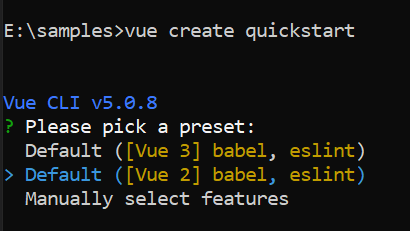Getting Started with the Vue Calendar Component in Vue 2
25 Apr 20257 minutes to read
This article provides a step-by-step guide for setting up a Vue 2 project using Vue-CLI and integrating the Syncfusion® Vue Calendar component using the Composition API / Options API
Prerequisites
System requirements for Syncfusion® Vue UI components
Dependencies
The list of dependencies required to use the Calendar component in your application is given below:
|-- @syncfusion/ej2-vue-calendars
|-- @syncfusion/ej2-base
|-- @syncfusion/ej2-data
|-- @syncfusion/ej2-vue-base
|-- @syncfusion/ej2-calendars
|-- @syncfusion/ej2-inputs
|-- @syncfusion/ej2-splitbuttons
|-- @syncfusion/ej2-lists
|-- @syncfusion/ej2-popups
|-- @syncfusion/ej2-buttonsSetting up the Vue 2 project
To generate a Vue 2 project using Vue-CLI, use the vue create command. Follow these steps to install Vue CLI and create a new project:
npm install -g @vue/cli
vue create quickstart
cd quickstart
npm run serveor
yarn global add @vue/cli
vue create quickstart
cd quickstart
yarn run serveWhen creating a new project, choose the option Default ([Vue 2] babel, eslint) from the menu.

Once the quickstart project is set up with default settings, proceed to add Syncfusion® components to the project.
Adding Syncfusion® packages
Syncfusion® packages are available at npmjs.com. To use Vue components, install the required npm package.
This article uses the Vue Calendar component as an example. Install the @syncfusion/ej2-vue-calendars package by running the following command:
npm install @syncfusion/ej2-vue-calendars --saveor
yarn add @syncfusion/ej2-vue-calendarsImport Syncfusion® CSS styles
You can import themes for the Syncfusion® Vue component in various ways, such as using CSS or SASS styles from npm packages, CDN, CRG and Theme Studio. Refer to themes topic to know more about built-in themes and different ways to refer to themes in a Vue project.
In this article, the Material theme is applied using CSS styles, which are available in installed packages. The necessary Material CSS styles for the Calendar component and its dependents were imported into the <style> section of src/App.vue file.
<style>
@import "../node_modules/@syncfusion/ej2-base/styles/material.css";
@import "../node_modules/@syncfusion/ej2-buttons/styles/material.css";
@import "../node_modules/@syncfusion/ej2-vue-calendars/styles/material.css";
</style>Add Syncfusion® Vue component
Follow the below steps to add the Vue Calendar component using Composition API or Options API:
1. First, import and register the Calendar component in the script section of the src/App.vue file. If you are using the Composition API, you should add the setup attribute to the script tag to indicate that Vue will be using the Composition API.
<script setup>
import { CalendarComponent as EjsCalendar } from '@syncfusion/ej2-vue-calendars';
</script><script>
import { CalendarComponent } from '@syncfusion/ej2-vue-calendars';
export default {
components: {
'ejs-calendar': CalendarComponent
}
}
</script>2. In the template section, define the Calendar component.
<template>
<div id="app">
<ejs-calendar ></ejs-calendar>
</div>
</template>Here is the summarized code for the above steps in the src/App.vue file:
<template>
<div id="app">
<div class='wrapper'>
<ejs-calendar></ejs-calendar>
</div>
</div>
</template>
<script setup>
import { CalendarComponent as EjsCalendar } from '@syncfusion/ej2-vue-calendars';
</script>
<style>
@import "../node_modules/@syncfusion/ej2-base/styles/material.css";
@import "../node_modules/@syncfusion/ej2-buttons/styles/material.css";
@import "../node_modules/@syncfusion/ej2-vue-calendars/styles/material.css";
.wrapper {
max-width: 250px;
margin: 0 auto;
}
</style><template>
<div id="app">
<div class='wrapper'>
<ejs-calendar></ejs-calendar>
</div>
</div>
</template>
<script>
import { CalendarComponent } from '@syncfusion/ej2-vue-calendars';
export default {
name: "App",
components: {
'ejs-calendar': CalendarComponent
}
}
</script>
<style>
@import "../node_modules/@syncfusion/ej2-base/styles/material.css";
@import "../node_modules/@syncfusion/ej2-buttons/styles/material.css";
@import "../node_modules/@syncfusion/ej2-vue-calendars/styles/material.css";
.wrapper {
max-width: 250px;
margin: 0 auto;
}
</style>Running the Project
To run the project, use the following command:
npm run serveor
yarn run serveSetting the value, min and max dates
The following example demonstrates how to set the value, min and max dates on initializing the Calendar. Here the Calendar allows you to select a date within the range from 9th to 15th in the month of May 2017. To know more about range restriction in Calendar, please refer this page.
<template>
<div id="app">
<div class='wrapper'>
<ejs-calendar :min="minDate" :max="maxDate" :value="dateVal"></ejs-calendar>
</div>
</div>
</template>
<script setup>
import { CalendarComponent as EjsCalendar } from '@syncfusion/ej2-vue-calendars';
const minDate = new Date("05/09/2017");
const maxDate = new Date("05/15/2017");
const dateVal = new Date("05/11/2017");
</script>
<style>
@import "../node_modules/@syncfusion/ej2-base/styles/material.css";
@import "../node_modules/@syncfusion/ej2-buttons/styles/material.css";
@import "../node_modules/@syncfusion/ej2-vue-calendars/styles/material.css";
.wrapper {
max-width: 250px;
margin: 0 auto;
}
</style><template>
<div id="app">
<div class='wrapper'>
<ejs-calendar :min="minDate" :max="maxDate" :value="dateVal"></ejs-calendar>
</div>
</div>
</template>
<script>
import { CalendarComponent } from '@syncfusion/ej2-vue-calendars';
export default {
name: "App",
components: {
'ejs-calendar': CalendarComponent
},
data() {
return {
minDate: new Date("05/09/2017"),
maxDate: new Date("05/15/2017"),
dateVal: new Date("05/11/2017")
}
}
}
</script>
<style>
@import "../node_modules/@syncfusion/ej2-base/styles/material.css";
@import "../node_modules/@syncfusion/ej2-buttons/styles/material.css";
@import "../node_modules/@syncfusion/ej2-vue-calendars/styles/material.css";
.wrapper {
max-width: 250px;
margin: 0 auto;
}
</style>